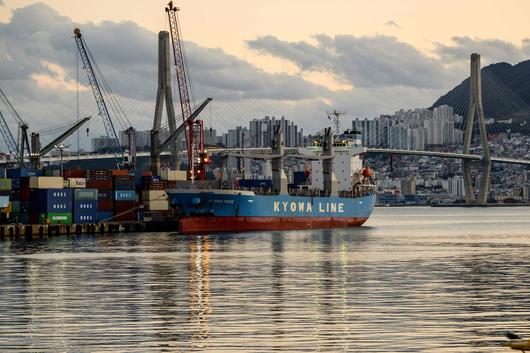Container oversupply and trade barriers cloud shipping industry’s future
While this surge has provided a temporary boost, it comes against a backdrop of looming trade tensions and market uncertainties. Industry experts warn that a second-term Trump administration’s protectionist trade policies and tariff barriers could lead to a long-term decline in shipping demand. Concerns are growing that the trend may reverse sharply after Trump’s inauguration in January 2025, when U.S.-China trade tensions are expected to escalate.
 |
Containers are stacked near a cargo vessel docked at a terminal in Busan, South Korea, on Nov. 24, 2024./AFP Yonhap News |
<이미지를 클릭하시면 크게 보실 수 있습니다> |
Shipping companies are experiencing a short-term boom fueled by record-breaking U.S. imports from China. In July, U.S. imports from China reached 1.02 million TEUs, the highest monthly figure on record. Container shipping, the primary mode of transporting manufactured goods, has benefited directly from this spike. According to shipping consultancy Sea-Intelligence, operating profits for major shipping lines in Q3 soared 600% year-over-year to $17.06 billion. South Korea’s HMM alone recorded an operating profit of 1.46 trillion won ($1.1 billion) during the same period.
Analysts note that the shipping surge mirrors patterns from the first Trump administration (2017–2021), during which pre-tariff export increases were followed by a significant downturn in shipping volumes. Trump has pledged to impose tariffs of up to 60% on Chinese goods, raising fears of a prolonged reduction in U.S.-China trade volumes. This mirrors the impact of his first administration, when global container trade growth slowed from 5.7% in 2017 to 4.4% in 2018, and further to 2.2% in 2019, as trade tensions escalated.
“Container shipping is disproportionately affected as it primarily handles finished goods, which are the main targets of trade disputes,” said Yang Jong-seo, a senior research fellow at the Export-Import Bank of Korea.
The shipping industry is also grappling with oversupply risks. Global container capacity increased by a record 3.05 million TEUs this year as shipping companies, flush with cash from the pandemic era, ordered new mega-ships to achieve economies of scale. While global container capacity is expected to grow by 7% annually through 2025, demand for containerized goods is projected to rise by just 1% per year, exacerbating the oversupply problem.
In the past, shipping companies mitigated oversupply by retiring older vessels. However, the current influx of new ships makes this strategy less viable. Additionally, the resolution of the Red Sea shipping crisis, which had temporarily driven up freight rates, could reduce long-haul detour routes and further pressure rates.
“The U.S. and China are both expected to experience slower economic growth next year, limiting shipping demand,” said Ok Woong-ki, a researcher at the Korea International Trade Association. “The container shipping market is likely to face structural oversupply, increasing downward pressure on freight rates.”
[Lee Jeong-gu]
- Copyrights ⓒ 조선일보 & chosun.com, 무단 전재 및 재배포 금지 -
이 기사의 카테고리는 언론사의 분류를 따릅니다.
기사가 속한 카테고리는 언론사가 분류합니다.
언론사는 한 기사를 두 개 이상의 카테고리로 분류할 수 있습니다.
언론사는 한 기사를 두 개 이상의 카테고리로 분류할 수 있습니다.


